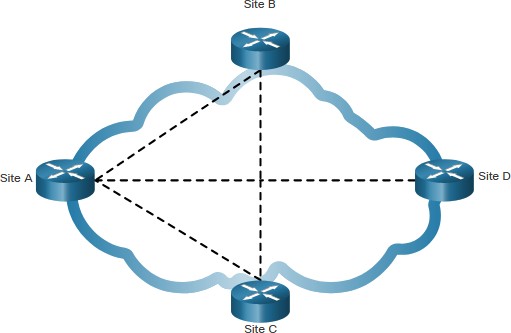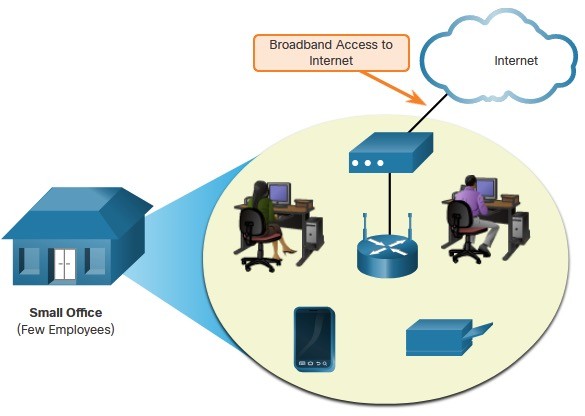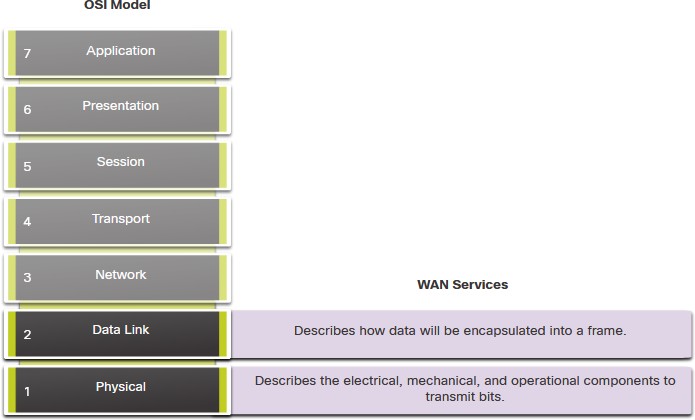
Module Title: WAN Concepts Module Objective: Explain how WAN access technologies can be used to satisfy business requirements.
| Topic Title | Topic Objective |
| Purpose of WANs | Explain the purpose of a WAN. |
| WAN Operations | Explain how WANs operate. |
| Traditional WAN Connectivity | Compare traditional WAN connectivity options. |
| Modern WAN Connectivity | Compare modern WAN connectivity options. |
| Internet-Based Connectivity | Compare internet-based connectivity options. |
Purpose of WANs
LANs and WANs
A WAN is a telecommunications network that spans over a relatively large geographical area and is required to connect beyond the boundary of the LAN. 
| Local Area Networks (LANs) | Wide Area Networks (WANs) |
| LANs provide networking services within a small geographic area. | WANs provide networking services over large geographical areas. |
| LANs are used to interconnect local computers, peripherals, and other devices. | WANs are used to interconnect remote users, networks, and sites. |
| A LAN is owned and managed by an organization or home user. | WANs are owned and managed by internet service, telephone, cable, and satellite providers. |
| Other than the network infrastructure costs, there is no fee to use a LAN. | WAN services are provided for a fee. |
| LANs provide high bandwidth speeds using wired Ethernet and Wi-Fi services. | WANs providers offer low to high bandwidth speeds, over long distances. |
Private and Public WANs
A private WAN is a connection that is dedicated to a single customer. Private WANs provide the following:
- Guaranteed service level
- Consistent bandwidth
- Security
A public WAN connection is typically provided by an ISP or telecommunications service provider using the internet. In this case, the service levels and bandwidth may vary, and the shared connections do not guarantee security.
WAN Topologies
WANs are implemented using the following logical topology designs:
- Point-to-Point Topology
- Hub-and-Spoke Topology
- Dual-homed Topology
- Fully Meshed Topology
- Partially Meshed Topology
Note: Large networks usually deploy a combination of these topologies.
Point-to-Point Topology
- Employs a point-to-point circuit between two endpoints.
- Involves a Layer 2 transport service through the service provider network.
- The point-to-point connection is transparent to the customer network.
 Note: It can become expensive if many point-to-point connections are required.
Note: It can become expensive if many point-to-point connections are required.
Hub-and-Spoke Topology
- Enables a single interface on the hub router to be shared by all spoke circuits.
- Spoke routers can be interconnected through the hub router using virtual circuits and routed subinterfaces.

- Spoke routers can only communicate with each other through the hub router.
Note: The hub router represents a single point of failure. If it fails, inter- spoke communication also fails.
Dual-homed Topology
- Offers enhanced network redundancy, load balancing, distributed computing and processing, and the ability to implement backup service provider connections.
- More expensive to implement than single-homed topologies. This is because they require additional networking hardware, such as additional routers and switches.
- More difficult to implement because they require additional, and more complex, configurations.
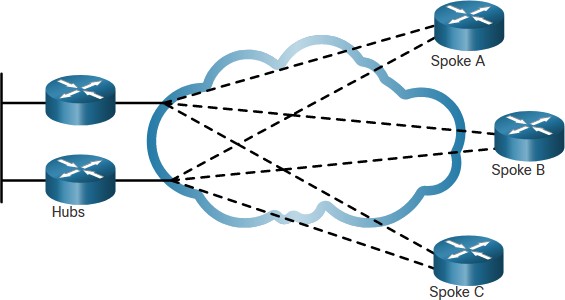
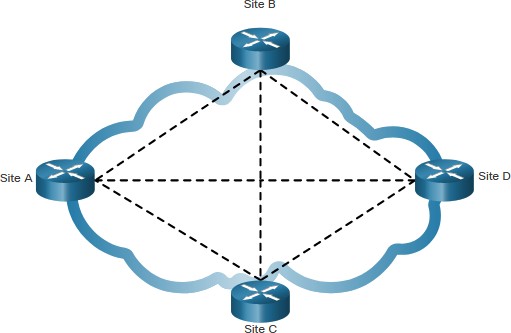
Fully Meshed Topology
- Uses multiple virtual circuits to connect all sites
- The most fault-tolerant topology
Partially Meshed Topology
- Connects many but not all sites
Carrier Connections
Another aspect of WAN design is how an organization connects to the internet. An organization usually signs a service level agreement (SLA) with a service provider. The SLA outlines the expected services relating to the reliability and availability of the connection. The service provider may or may not be the actual carrier. A carrier owns and maintains the physical connection and equipment between the provider and the customer. Typically, an organization will choose either a single-carrier or dual-carrier WAN connection.
Carrier Connections (Cont.)
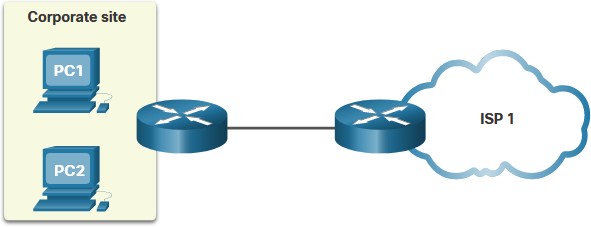 A single-carrier connection is when an organization connects to only one service provider. An SLA is negotiated between the organization and the service provider.
A single-carrier connection is when an organization connects to only one service provider. An SLA is negotiated between the organization and the service provider. 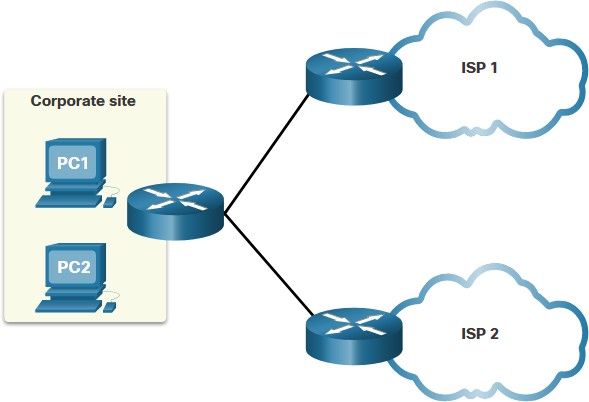 A dual-carrier connection provides redundancy and increases network availability. The organization negotiates separate SLAs with two different service providers.
A dual-carrier connection provides redundancy and increases network availability. The organization negotiates separate SLAs with two different service providers.
Evolving Networks
Network requirements of a company can change dramatically as the company grows over time.
- A network must meet the day-to-day operational needs of business, and it must be able to adapt and grow as a company changes.
- Network designers and administrators meet these challenges by carefully choosing network technologies, protocols, and service providers.
- Networks can be optimized by using a variety of network design techniques and architectures.
To illustrate differences between network size, we will use a fictitious company called SPAN Engineering as it grows from a small, local, business into a global enterprise.
Small Network
SPAN, a small fictitious company, started with a few employees in a small office.
- Uses a single LAN connected to a wireless router for sharing data and peripherals.
- Connection to the internet is through a common broadband service called Digital Subscriber Line (DSL)
- IT support is contracted from the DSL provider.
Campus Network
Within a few years SPAN grew and required several floors of a building. The company now required a Campus Area Network (CAN).
- A firewall secures internet access to corporate users.
- In-house IT staff to support and maintain the network.
Branch Network
- A few years later, the company expanded and added a branch site in the city, and remote and regional sites in other cities.
- The company now required a metropolitan area network (MAN) to interconnect sites within the city.
- To connect to the central office, branch offices in nearby cities used private dedicated lines through their local service provider.
Distributed Network
- SPAN Engineering has now been in business for 20 years and has grown to thousands of employees distributed in offices worldwide.
- Site-to-site and remote access Virtual Private Networks (VPNs) enable the company to use the internet to connect easily and securely with employees and facilities around the world.
WAN Operation
WAN Standards
Modern WAN standards are defined and managed by a number of recognized authorities including the following:
- TIA/EIA – Telecommunications Industry Association and Electronic Industries Alliance
- ISO – International Organization for Standardization
- IEEE – Institute of Electrical and Electronics Engineers
WANs in the OSI Model
Most WAN standards focus on the physical layer and the data link layer.
Layer 1 Protocols
- Synchronous Digital Hierarchy (SDH)
- Synchronous Optical Networking (SONET)
- Dense Wavelength Division Multiplexing (DWDM)
Layer 2 Protocols
- Broadband (i.e., DSL and Cable)
- Wireless
- Ethernet WAN (Metro Ethernet)
- Multiprotocol Label Switching (MPLS)
- Point-to-Point Protocol (PPP) (less used)
- High-Level Data Link Control (HDLC) (less used)
- Frame Relay (legacy)
- Asynchronous Transfer Mode (ATM) (legacy)
Common WAN Terminology
 There are specific terms used to describe WAN connections between the subscriber (i.e., the company / client) and the WAN service provider.
There are specific terms used to describe WAN connections between the subscriber (i.e., the company / client) and the WAN service provider.
| WAN Term | Description |
| Data Terminal Equipment (DTE) | Connects the subscriber LANs to the WAN communication device |
| Data Communications Equipment (DCE) | Device used to communicate with the provider |
| Customer Premises Equipment (CPE) | This is the DTE and DCE devices located on the enterprise edge |
| Point-of-Presence (POP) | The point where the subscriber connects to the service provider network |
| Demarcation Point | The physical location in a building or complex that officially separates the CPE from service provider equipment. |
| WAN Term | Description |
| Local Loop (last mile) | The copper or fiber cable that connects the CPE to the CO of the service provider |
| Central office (CO) | The local service provider facility or building that connects the CPE to the provider network |
| Toll network | Includes backhaul, long-haul, all-digital, fiber-optic communications lines, switches, routers, and other equipment inside the WAN provider network |
| Backhaul network | Connects multiple access nodes of the service provider network |
| Backbone network | Large, high-capacity networks used to interconnect service provider networks and to create a redundant network. |
WAN Devices
There are many types of devices that are specific to WAN environments. 
| WAN Device | Description |
| Voiceband Modem | Dial-up modem – uses telephone lines Legacy device |
| DSL Modem / Cable Modem | Collectively known as broadband modems, these high-speed digital modems connect to the DTE router using Ethernet. |
| CSU/DSU | Digital-leased lines require a CSU and a DSU. It connects a digital device to a digital line. |
| Optical Converter | Connect fiber-optic media to copper media and convert optical signals to electronic pulses. |
| Wireless Router / Access Point | Devices are used to wirelessly connect to a WAN provider. |
| WAN Core devices | WAN backbone consists of multiple high-speed routers and Layer 3 switches. |
Serial Communication
- Almost all network communications occur using a serial communication delivery. Serial communication transmits bits sequentially over a single channel.
- In contrast, parallel communications simultaneously transmit several bits using multiple wires.
- As the cable length increases, the synchronization timing between multiple channels becomes more sensitive to distance. For this reason, parallel communication is limited to very short distances
Circuit-Switched Communication
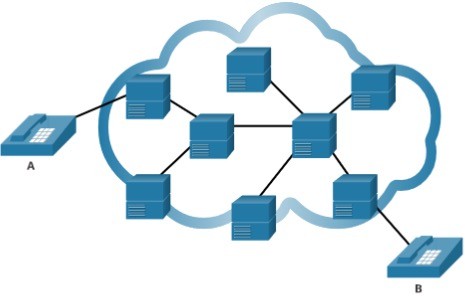 A circuit-switched network establishes a dedicated circuit (or channel) between endpoints before the users can communicate.
A circuit-switched network establishes a dedicated circuit (or channel) between endpoints before the users can communicate.
- Establishes a dedicated virtual connection through the service provider network before communication can start.
- All communication uses the same path.
- The two most common types of circuit- switched WAN technologies are the public switched telephone network (PSTN) and the legacy Integrated Services Digital Network (ISDN).
Packet-Switched Communication
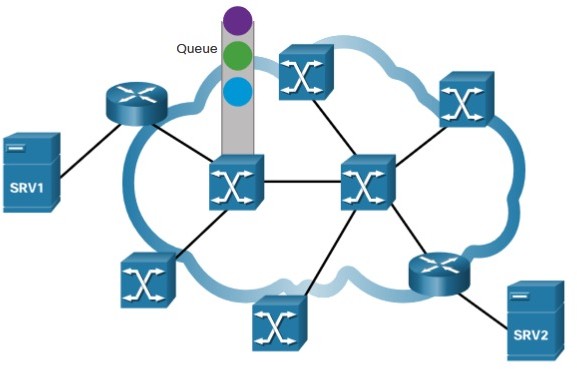 Network communication is most commonly implemented using packet-switched communication.
Network communication is most commonly implemented using packet-switched communication.
- Segments traffic data into packets that are routed over a shared network.
- Much less expensive and more flexible than circuit switching.
- Common types of packet-switched WAN technologies are:
- Ethernet WAN (Metro Ethernet),
- Multiprotocol Label Switching (MPLS)
- Frame Relay
- Asynchronous Transfer Mode (ATM).
SDH, SONET, and DWDM
Service provider networks use fiber-optic infrastructures to transport user data between destinations. Fiber-optic cable is far superior to copper cable for long distance transmissions due to its much lower attenuation and interference. There are two optical fiber OSI layer 1 standards available to service providers:
- SDH – Synchronous Digital Hierarchy (SDH) is a global standard for transporting data over fiber-optic cable.
- SONET – Synchronous Optical Networking (SONET) is the North American standard that provides the same services as SDH.
SDH/SONET define how to transfer multiple data, voice, and video communications over optical fiber using lasers or light-emitting diodes (LEDs) over great distances. Dense Wavelength Division Multiplexing (DWDM) is a newer technology that increases the data-carrying capacity of SDH and SONET by simultaneously sending multiple streams of data (multiplexing) using different wavelengths of light.
Traditional WAN Connectivity
Traditional WAN Connectivity Options
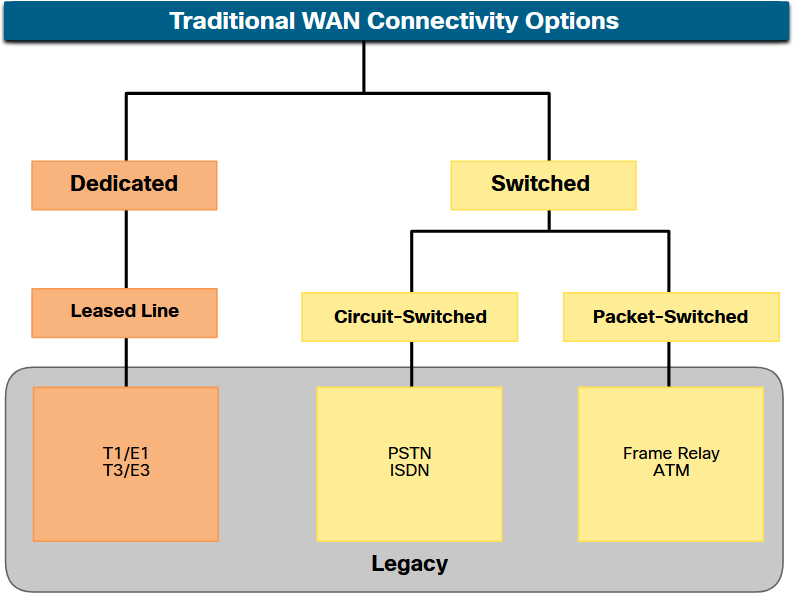 To understand the WANs of today, it helps to know where they started.
To understand the WANs of today, it helps to know where they started.
- When LANs appeared in the 1980s, organizations began to see the need to interconnect with other locations.
- To do so, they needed their networks to connect to the local loop of a service provider.
- This was accomplished by using dedicated lines, or by using switched services from a service provider.
Common WAN Terminology
Point-to-point lines could be leased from a service provider and were called “leased lines”. The term refers to the fact that the organization pays a monthly lease fee to a service provider to use the line.
- Leased lines are available in different fixed capacities and are generally priced based on the bandwidth required and the distance between the two connected points.
- There are two systems used to define the digital capacity of a copper media serial link:
- T-carrier – Used in North America, T-carrier provides T1 links supporting bandwidth up to 1.544 Mbps and T3 links supporting bandwidth up to 43.7 Mbps.
- E-carrier – Used in Europe, E-carrier provides E1 links supporting bandwidth up to 2.048 Mbps and E3 links supporting bandwidth up to 34.368 Mbps.
The table summarizes the advantages and disadvantages of leased lines.
| Advantages | |
| Simplicity | Point-to-point communication links require minimal expertise to install and maintain. |
| Quality | Point-to-point communication links usually offer high quality service, if they have adequate bandwidth. |
| Availability | Constant availability is essential for some applications, such as e-commerce. Point-to-point communication links provide permanent, dedicated capacity which is required for VoIP or Video over IP. |
| Disadvantages | |
| Cost | Point-to-point links are generally the most expensive type of WAN access. The cost of leased line solutions can become significant when they are used to connect many sites over increasing distances. |
| Limited flexibility | WAN traffic is often variable, and leased lines have a fixed capacity, so that the bandwidth of the line seldom matches the need exactly. |
Circuit-Switch Options
Circuit-switched connections are provided by Public Service Telephone Network (PSTN) carriers. The local loop connecting the CPE to the CO is copper media. There are two traditional circuit-switched options:
Public Service Telephone Network (PSTN)
- Dialup WAN access uses the PSTN as its WAN connection. Traditional local loops can transport binary computer data through the voice telephone network using a voiceband modem.
- The physical characteristics of the local loop and its connection to the PSTN limit the rate of the signal to less than 56 kbps.
Integrated Services Digital Network (ISDN)
- ISDN is a circuit-switching technology that enables the PSTN local loop to carry digital signals. This provided higher capacity switched connections than dialup access. ISDN provides for data rates from 45 Kbps to 2.048 Mbps.
Packet-Switch Options
Packet switching segments data into packets that are routed over a shared network. It allows many pairs of nodes to communicate over the same channel. There are two traditional (legacy) circuit-switched options:
Frame Relay
- Frame Relay is a simple Layer 2 non-broadcast multi-access (NBMA) WAN technology that is used to interconnect enterprise LANs.
- Frame Relay creates PVCs which are uniquely identified by a data-link connection identifier (DLCI).
Asynchronous Transfer Mode (ATM)
- Asynchronous Transfer Mode (ATM) technology is capable of transferring voice, video, and data through private and public networks.
- ATM is built on a cell-based architecture rather than on a frame-based architecture. ATM cells are always a fixed length of 53 bytes.
Note: Frame relay and ATM networks have been largely replaced by faster Metro Ethernet and internet-based solutions.
Modern WAN Connectivity
Modern WANs
Modern WANS have more connectivity options than traditional WANs.
- Enterprises now require faster and more flexible WAN connectivity options.
- Traditional WAN connectivity options have rapidly declined in use because they are either no longer available, too expensive, or have limited bandwidth.
 The figure displays the local loop connections most likely encountered today.
The figure displays the local loop connections most likely encountered today.
Modern WAN Connectivity Options
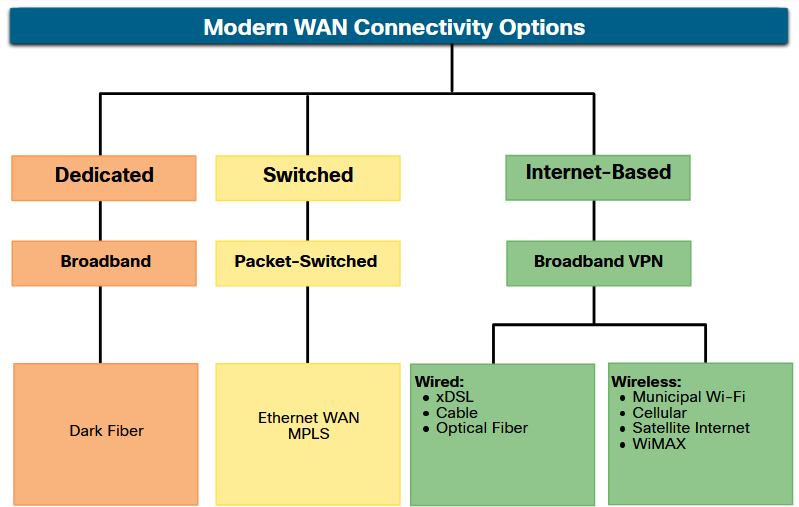 New technologies are continually emerging. The figure summarizes the modern WAN connectivity options. Dedicated broadband
New technologies are continually emerging. The figure summarizes the modern WAN connectivity options. Dedicated broadband
- Fiber can be installed independently by an organization to connect remote locations directly together.
- Dark fiber can be leased or purchased from a supplier.
Packet-switched
- Metro Ethernet – Replacing many traditional WAN options.
- MPLS – Enables sites to connect to the provider regardless of its access technologies.
Internet-based broadband
- Organizations are now commonly using the global internet infrastructure for WAN connectivity.
Ethernet WAN
 Service providers now offer Ethernet WAN service using fiber-optic cabling. The Ethernet WAN service can go by many names, including the following:
Service providers now offer Ethernet WAN service using fiber-optic cabling. The Ethernet WAN service can go by many names, including the following:
- Metropolitan Ethernet (Metro E)
- Ethernet over MPLS (EoMPLS)
- Virtual Private LAN Service (VPLS)
There are several benefits to an Ethernet WAN:
- Reduced expenses and administration
- Easy integration with existing networks
- Enhanced business productivity
Note: Ethernet WANs have gained in popularity and are now commonly being used to replace the traditional serial point-to-point, Frame Relay and ATM WAN links.
MPLS
Multiprotocol Label Switching (MPLS) is a high-performance service provider WAN routing technology to interconnect clients without regard to access method or payload.
- MPLS supports a variety of client access methods (e.g., Ethernet, DSL, Cable, Frame Relay).
- MPLS can encapsulate all types of protocols including IPv4 and IPv6 traffic.
- An MPLS router can be a customer edge (CE) router, a provider edge (PE) router, or an internal provider (P) router.
- MPLS routers are label switched routers (LSRs). They attach labels to packets that are then used by other MPLS routers to forward traffic.
- MPLS also provides services for QoS support, traffic engineering, redundancy, and VPNs.

Internet-Based Connectivity
Internet-Based Connectivity Options
Internet-based broadband connectivity is an alternative to using dedicated WAN options.  Internet-based connectivity can be divided into wired and wireless options. Wired Options
Internet-based connectivity can be divided into wired and wireless options. Wired Options
- Wired options use permanent cabling (e.g., copper or fiber) to provide consistent bandwidth, and reduce error rates and latency. Examples: DSL, cable connections, and optical fiber networks.
Wireless Options
- Wireless options are less expensive to implement compared to other WAN connectivity options because they use radio waves instead of wired media to transmit data. Examples: cellular 3G/4G/5G or satellite internet services.
- Wireless signals can be negatively affected by factors such as distance from radio towers, interference from other sources and weather.
DSL Technology
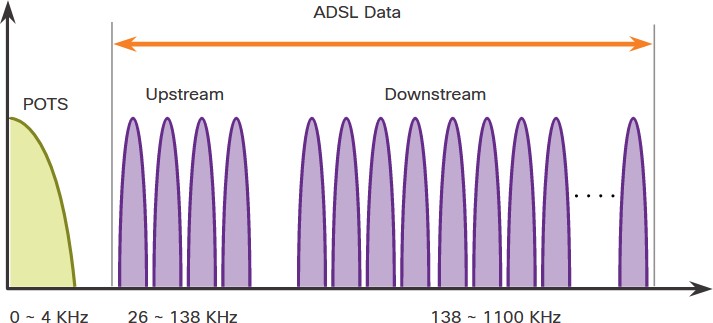 Digital Subscriber Line (DSL) is a high-speed, always-on, connection technology that uses existing twisted-pair telephone lines to provide IP services to users. DSL are categorized as either Asymmetric DSL (ADSL) or Symmetric DSL (SDSL).
Digital Subscriber Line (DSL) is a high-speed, always-on, connection technology that uses existing twisted-pair telephone lines to provide IP services to users. DSL are categorized as either Asymmetric DSL (ADSL) or Symmetric DSL (SDSL).
- ADSL and ADSL2+ provide higher downstream bandwidth to the user than upload bandwidth.
- SDSL provides the same capacity in both directions.
DSL transfer rates are dependent on the actual length of the local loop, and the type and condition of the cabling.
DSL Connections
Service providers deploy DSL connections in the local loop. The connection is set up between the DSL modem and the DSL access multiplexer (DSLAM).
- The DSL modem converts the Ethernet signals from the teleworker device to a DSL signal, which is transmitted to a DSL access multiplexer (DSLAM) at the provider location.
- A DSLAM is located at the Central Office (CO) of the provider and concentrates connections from multiple DSL subscribers.
- DSL is not a shared medium. Each user has a separate direct connection to the DSLAM. Adding users does not impede performance.

DSL and PPP
ISPs use PPP as the Layer 2 protocol for broadband DSL connections.
- PPP can be used to authenticate the subscriber.
- PPP can assign a public IPv4 address to the subscriber.
- PPP provides link-quality management features.
There are two ways PPP over Ethernet (PPPoE) can be deployed:
- Host with PPoE Client – The PPPoE client software communicates with the DSL modem using PPPoE and the modem communicates with the ISP using PPP.
- Router PPPoE Client – The router is the PPPoE client and obtains its configuration from the provider.


Cable Technology
Cable technology is a high-speed always-on connection technology that uses a coaxial cable from the cable company to provide IP services to users. The Data over Cable Service Interface Specification (DOCSIS) is the international standard for adding high-bandwidth data to an existing cable system.
- The optical node converts RF signals to light pulses over fiber-optic cable.
- The fiber media enables the signals to travel over long distances to the provider headend where a Cable Modem Termination System (CMTS) is located.
- The headend contains the databases needed to provide internet access while the CMTS is responsible for communicating with the cable modems.
 Note: All the local subscribers share the same cable bandwidth. As more users join the service, available bandwidth may drop below the expected rate.
Note: All the local subscribers share the same cable bandwidth. As more users join the service, available bandwidth may drop below the expected rate.
Optical Fiber
Many municipalities, cities, and providers install fiber-optic cable to the user location. This is commonly referred to as Fiber to the x (FTTx) and includes the following:
- Fiber to the Home (FTTH) – Fiber reaches the boundary of the residence.
- Fiber to the Building (FTTB) – Fiber reaches the boundary of the building with the final connection to the individual living space being made via alternative means.
- Fiber to the Node/Neighborhood (FTTN) – Optical cabling reaches an optical node that converts optical signals to a format acceptable for twisted pair or coaxial cable to the premise.
Note: FTTx can deliver the highest bandwidth of all broadband options.
Wireless Internet-Based Broadband
Wireless technology uses the unlicensed radio spectrum to send and receive data.
- Municipal Wi-Fi – Municipal wireless networks are available in many cities providing high-speed internet access for free, or for substantially less than the price of other broadband services.
- Cellular – Increasingly used to connect devices to the internet using radio waves to communicate through a nearby mobile phone tower. 3G/4G/5G and Long-Term Evolution (LTE) are cellular technologies.
- Satellite Internet – Typically used by rural users or in remote locations where cable and DSL are not available. A router connects to a satellite dish which is pointed to a service provider satellite in Geosynchronous orbit. Trees and heavy rains can impact the satellite signal.
- WiMAX – Worldwide Interoperability for Microwave Access (WiMAX) is described in the IEEE standard 802.16 Provides high-speed broadband service with wireless access and provides broad coverage like a cell phone network rather than through small Wi-Fi hotspots.
VPN Technology
VPNs can be used to address security concerns incurred when a remote office worker uses broadband services to access the corporate WAN over the internet. A VPN is an encrypted connection between private networks over a public network. VPN tunnels are routed through the internet from the private network of the company to the remote site or employee host. There are several benefits to using VPN:
- Cost savings – Eliminates expensive, dedicated WAN links and modem banks.
- Security – Advanced encryption and authentication protocols protect data from unauthorized access.
- Scalability – Corporations can add large amounts of capacity without adding significant infrastructure.
- Compatibility with broadband technology – Supported by broadband service providers such as DSL and cable.
VPNs are commonly implemented as the following:
- Site-to-site VPN – VPN settings are configured on routers. Clients are unaware that their data is being encrypted.
- Remote Access – The user is aware and initiates remote access connection. For example, using HTTPS in a browser to connect to your bank. Alternatively, the user can run VPN client software on their host to connect to and authenticate with the destination device.
ISP Connectivity Options
There are different ways an organization can connect to an ISP. The choice depends on the needs and budget of the organization.
- Single-homed –Single connection to the ISP using one link. Provides no redundancy and is the least expensive solution.

- Dual-homed – Connects to the same ISP using two links. Provides both redundancy and load balancing. However, the organization loses internet connectivity if the ISP experiences an outage.

- Multihomed -The client connects to two different ISPs. This design provides increased redundancy and enables load- balancing, but it can be expensive.
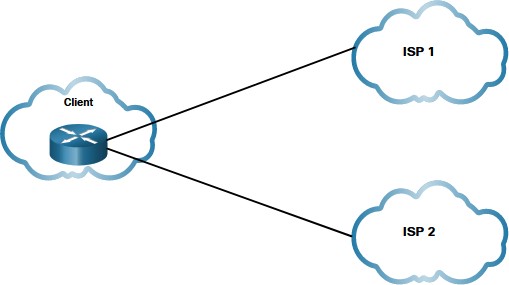
- Dual-multihomed – Dual-multihomed is the most resilient topology of the four shown. The client connects with redundant links to multiple ISPs. This topology provides the most redundancy possible. It is the most expensive option of the four.
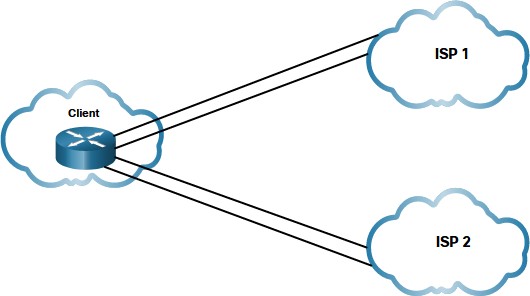
Broadband Solution Comparison
Each broadband solution has advantages and disadvantages. If there are multiple broadband solutions available, a cost-versus-benefit analysis should be performed to determine the best solution. Some factors to consider include the following:
- Cable – Bandwidth is shared by many users. Therefore, upstream data rates are often slow during high-usage hours in areas with over-subscription.
- DSL – Limited bandwidth that is distance sensitive (in relation to the ISP central office). Upload rate is proportionally lower compared to download rate.
- Fiber-to-the-Home – This option requires fiber installation directly to the home.
- Cellular/Mobile – With this option, coverage is often an issue, even within a small office or home office where bandwidth is relatively limited.
- Municipal Wi-Fi – Most municipalities do not have a mesh Wi-Fi network deployed. If is available and in range, then it is a viable option.
- Satellite – This option is expensive and provides limited capacity per subscriber. Typically used when no other option is available.
